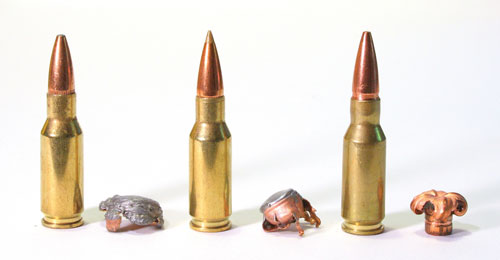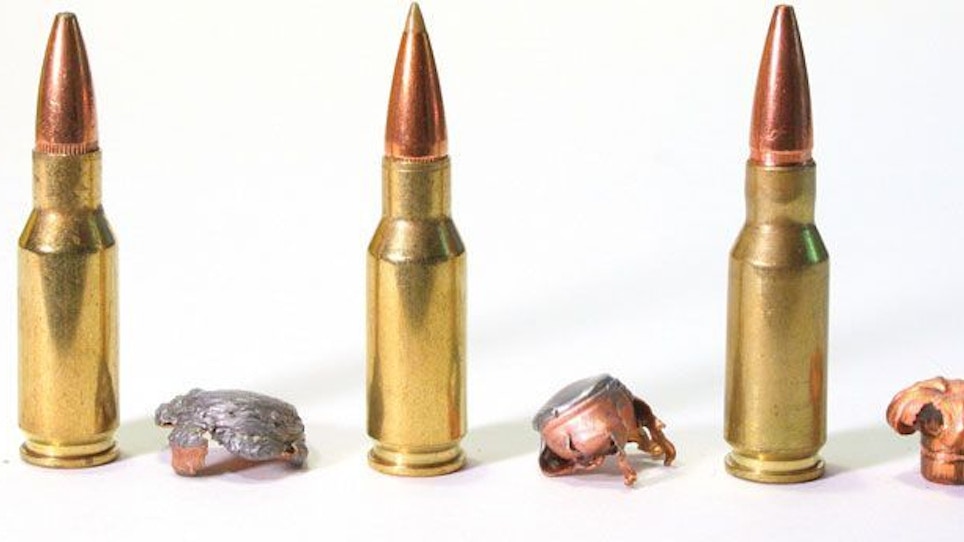 In the pines, in the pines, where the sun never shines — I’m talking deep woods. Back behind the food plots, grown-up pastures, clearcuts and thickets. To me, deep woods means two things — you’re a long way from the truck and you’re in big timber. What deer cartridges work in the deep woods?
In the pines, in the pines, where the sun never shines — I’m talking deep woods. Back behind the food plots, grown-up pastures, clearcuts and thickets. To me, deep woods means two things — you’re a long way from the truck and you’re in big timber. What deer cartridges work in the deep woods?
Actually, all of them. A .300 WSM will kill a deer in the deep woods just as easy as it will across your neighbor’s big cornfield. Is it the most perfectly suited cartridge to the task? I don’t think so. You see, most .300 WSM rifles are moderately heavy, long-barreled bolt-actions. They’re perfectly suited to hunting a diverse countryside, but in the deep woods, you don’t need all that reach, muzzle blast or recoil.
The great thing about our society is that there’s a special tool for just about anything you want to do, no matter how specialized that need is. Want to drive your SUV only on the highway? They make tires just for that. Want to take your luxury car and climb rock piles? Buy a Land Rover. This versatility extends to guns and cartridges, too.
In the deep woods you’ll only need to shoot about 150 yards, because that’s about as far as you’ll be able to see. I do a lot of deer hunting on public land in the deep woods. My farthest shot was 127 yards. This means you will not need a high-velocity/flat-shooting cartridge like a 7mm Remington Magnum.
If you’re going deep, you’ll also be walking a long ways. If you’re carrying a deer stand or a blind with you, you won’t walk far before you’ll be wishing someone else was carrying your 9-pound wonder rifle. I know, grown men should not complain about rifle weight, but what about when you’re dragging that 200-pound antlered giant back to the truck? A true, light rifle will weigh less than 7 pounds with scope, ruling out most rifles chambered for mega-magnums, as well as many even more common deer cartridges.
We’ve all heard the virtues of brush guns like the .35 Remington and the .45-70. The idea being that big, slow-moving bullets can pound their way through a laurel bush or a deadfall and still knock a whitetail on his backside. In actuality, those big heavy bullets are no better at “busting brush” than moderately sized, higher-velocity bullets like those fired from a .308 Winchester. I believe these cartridges got their brush-busting reputation because they were chambered in quick-handling rifles that permitted fast shooting in close quarters.
Sights And Optics
Deep-woods whitetail hunting can be a quick-shooting, reactionary proposition. Heck, if you’re hunting the rut, hunting anywhere can be a fast-paced! One of the biggest differences between hunting the deep woods and hunting a food plot or prairie is you’ll have to whack the deer as he moves between big trees. To do this you need a riflescope with a wide field of view. This lets you keep the deer in the scope as he’s moving, while still looking ahead for an opening to shoot through. Open sights work great for this, but in the deep timber it will get dark about 30 minutes before it does on the edge of a bean field. Open sights limit your ability to accurately place shots in the low light. A wide objective scope to let light in, and a variable magnification of about 2-7X is ideal.
Rifle And Cartridge
Some hunters put the cart ahead of the horse and decide on a cartridge before they pick their rifle and scope. I think this is backwards. You need a rifle that fits your hunting style and you. This is infinitely more important than what cartridge your rifle is chambered for. White-tailed deer are not that hard to kill. I’ve taken them successfully with everything from a .223 Remington to a .35 Whelen. By narrowing your deep woods rifle to one that weighs 7 pounds with a scope, your base rifle weight will need to be about 6 ½ pounds or less. In most cases this means something built around a short-action sized for .308 Winchester length cartridges.
A perfect example would be Remington’s Model Seven. It weighs about 6.5 pounds and is chambered for the .223 Remington, .243 Winchester, .260 Remington, 7mm-08 Remington and the .308 Winchester. Ruger’s Compact Model 77, Browning’s X Bolt Hunter and Marlin’s XL7S weigh about the same as the Remington Model Seven. Any of these rifles in these cartridges are deer-capable out to 150 yards. Personally, I’d pass on the .223 Remington because I might want to take a bad angle, quartering-away shot on a monster buck and because it’s not a legal big-game cartridge everywhere.
But what about lever guns? At first blush, a Marlin lever action in .30-30, .35 Remington or even .45-70 might seem fitting, but they weigh in at 7 pounds without a scope. They’re also butt-heavy. This makes them fast-handling for snap shooting but harder to hold steady for a longer shot where you might have to steer the bullet between a gap in the trees. If you really want a deep-woods lever gun, consider Browning’s Lightweight BLR. It is available in the same cartridges and even .358 Winchester; a notorious whitetail-woods cartridge. The takedown version of this rifle could be especially handy if you’re packing in for a long ways.
Regardless, any of the short-action cartridges mentioned and others like the .257 Roberts will do the trick. In all honesty, the terminal effects of one cartridge in this list over another are mostly exaggerated by hunters who are swayed by some emotional attachment to a particular cartridge. Maybe dad used a .243 or a .30-06. Or maybe your buddy has a .338 Winchester Magnum and you don’t want to feel like a sissy.
 I’ve taken enough deer with enough different cartridges and tested enough cartridges and different bullets in ordnance gelatin to know that, as far was whitetail at deep-woods ranges are concerned, the differences in terminal performance are minimal. Even bullet selection — within reason — is not that important with the short-action cartridges mentioned. Granted, you’re a knothead if you use a varmint bullet for deer in any cartridge. But if you use a big-game bullet from a .243 Winchester or a .358 Winchester and hit ’em right, you’ll get your deer.
I’ve taken enough deer with enough different cartridges and tested enough cartridges and different bullets in ordnance gelatin to know that, as far was whitetail at deep-woods ranges are concerned, the differences in terminal performance are minimal. Even bullet selection — within reason — is not that important with the short-action cartridges mentioned. Granted, you’re a knothead if you use a varmint bullet for deer in any cartridge. But if you use a big-game bullet from a .243 Winchester or a .358 Winchester and hit ’em right, you’ll get your deer.
Some that hunt the Great White North where the largest whitetails live will argue the .243 is not enough gun. Tests in ordnance gelatin show otherwise. A 100-grain CoreLokt Ultra bullet fired from a .243 Winchester at 2,900 fps penetrates just as deep as a 150-grain CoreLokt Ultra bullet fired from a .308 Winchester at 2,780 fps. You can see a real penetration difference with a bullet like the Barnes Triple Shock in the .308 Winchester. It will penetrate about 25 percent deeper.
My go-to deep-woods deer rifle is a custom bolt-action rifle from New Ultra Light Arms. It weighs 5.25 pounds with the 1.5 - 5X Leupold scope. It’s only 39 inches long and balances right between my hands. The rifle is chambered for the .30 Remington AR, a cartridge originally designed to make the AR-15 big-game capable. It’s not a magnum by any stretch. Actually, it duplicates the ballistics of the time proven .300 Savage cartridge, and who knows how many deep-woods deer the .300 Savage has accounted for?
As with most rifle hunting pursuits, for all practical purposes it’s the rifle that matters most. If you can’t shoot your rifle well, it won’t matter what cartridge it’s chambered for. A cartridge that will kill a deer in the open fields or in the thick brush will work just as well in the deep woods. In those deep, dark woods, you just won’t need to reach out as far to hit that big buck’s shoulder.






